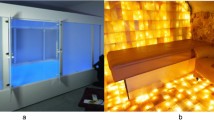Summary
A method of producing decerebrate rigidity in cats by means of a radiofrequency current was developed. Adequate control of the extent and shape of the lesions necessitated a preliminary investigation of the relationship between the intensity and duration of current, the size of the lesion, and the tissue impedance before and after destruction; this was performed on guinea pigs.
The mesencephalic reticulum in cats was identified by depth microelectrode recording and electrical stimulation. Unilateral, midline, and combined stereotactic radiofrequency lesions were made. The anatomical location, the pathological characteristics, and the physiological significance of the lesions with regard to the production of decerebrate rigidity and of the other clinical reactions of the animals are discussed.
Similar content being viewed by others
References
Aronow, S., The use of radio-frequency power in making lesions in the brain. Neurosurg.17 (1960), 431–438.
Bazet, H. C., Penfield, W. G., A study of the Sherringtonian decerebrate animal in the chronic as well as the acute conditions. Brain45 (1924), 185–264.
Borison, H. L., Clark, W. G., Rosenstein, R., Functional decerebration in the cat. Neurology10 (1960), 931–941.
Brodkey, J. S., Miyazaki, Y., Ervin, F. R., Mark, V. H., Reversible heat lesions with radiofrequency current. A method of stereotactic localization. Neurosurg.21 (1964), 49–53.
Brown, G. T., On postural and non-postural activities of the midbrain. Proc. Roy. Soc. (London) Series B,87 (1914), 145–163.
Cooper, I. S., A cryogenic method for physiological inhibition and production of lesions in the brain. Neurosurg.19 (1962), 853–858.
Creed, R. S., Denny-Brown, D., Eccles, J. C., Liddell, E. G., Sherrington, C. S., Reflex activity of the spinal cord. London: Oxford University Press. 1972.
Denny-Brown, D., The midbrain and motor integration. Sherrington Memorial Lecture. Roy. Soc. Med.55 (1962), 527–538.
Denny-Brown, D., The cerebral control of movement. The Sherrington Lectures VIII. Liverpool: University Press. 1966.
Gilman, S., Van der Meulen, J. P., Cryogenic decerebration. Arch. Neurol.13 (1965), 297–306.
Ingram, W. R., Ransom, S. W., Effects of lesions in the red nuclei in cats. Arch. Neurol. Psychiat. (Chicago)28 (1932), 484–512.
Ingram, W. R., Ransom, S. W., Hannett, F. I., Zeis, F. R., Terwillinger, E. R., Results of stimulation of the tegmentum with the Horsley-Clarke stereotactic apparatus. Arch. Neurol. Psychiat. (Chicago)28 (1932), 513–541.
Lance, J. W., A physiological approach to clinical neurology. London: Butterworths. 1970.
Lindgren, P., Rosen, A., Stranberg, P., Unvas, B., The sympathetic vasodilator outflow—a corticospinal autonomic pathway. J. Comp. Neurol.105 (1956), 95–109.
Lindsley, D. B., Bowden, J. W., Magoun, H. W., Effect upon the EEG of acute injury to the brain stem activating system. EEG and Clin. Neurophysiol.1 (1949), 475–486.
Mettler, P. A., Muscular tone and movement — their cerebral control in primates. Neurosci. Res.1 (1968), 175–250.
Pollock, L. J., Davis, L., Studies in decerebration. I. A method of decerebration. Arch. Neurol. Psychiat.10 (1923), 391–398.
Ranson, S. W., Hinsey, J. C., Extensor tonus after transection of the brain stem at varying levels. J. Nerv. Ment. Dis.70 (1929), 584–597.
Sherrington, C. S., Decerebrate rigidity and reflex coordination of movements. J. Physiol.22 (1897/98), 319–332.
Siegfried, J., Ervin, F. R., Miyazaki, Y., Mark, V. H., Localized cooling of the central nervous system. I. Neurophysiological studies in experimental animals. J. Neurosurg.19 (1962), 840–852.
Snider, R. S., Niemer, W. I., A stereotactic atlas of the cat brain. Chicago and London: University of Chicago Press. 1964.
Sprague, J. M., Chambers, W. W., Control of posture by reticular formation and cerebellum in the intact, anaesthetised and un-anaesthetised, and in the decerebrate cat. Amer. J. Physiol.176 (1954), 52–64.
Sprague, J. M., Chambers, W. W., Stellar, E., Attentive, effective and adoptive behaviour in the cat. Sensory deprivation of the forebrain by pesions in the brain stem results in striking behavioural abnormalities. Science133 (1961), 165–173.
Sweet, W. H., Mark, V. H., Hamlin, H., Radiofrequency lesions in the central nervous system of man and cat: including case reports of eight bulbar pain-tract interruptions. J. Neurosurg.17 (1960), 213–225.
Taren, J. A., Davis, R., Crosby, E. C., Target physiologic corroboration in stereotactic cervical cordotomy. J. Neurosurg.30 (1968), 569–576.
Ward, A. A., Decerebrate rigidity. J. Neurophysiol.10 (1947), 89–103.
Woodworth, R., Sherrington, C. S., A pseudoaffective reflex and its spinal path. J. Physiol.31 (1904), 234.
Author information
Authors and Affiliations
Rights and permissions
About this article
Cite this article
Tsementzis, S.A., Gillingham, F.J., Gordon, A. et al. Decerebrate rigidity produced in cats by focal stereotactic radiofrequency lesions. Acta neurochir 59, 13–33 (1981). https://doi.org/10.1007/BF01411188
Issue Date:
DOI: https://doi.org/10.1007/BF01411188




